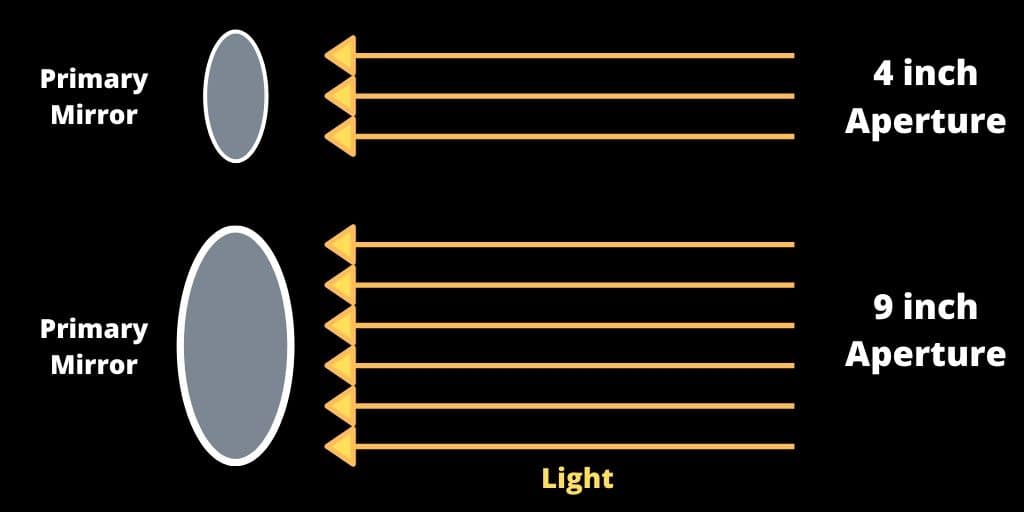Can you see the Moon landing sites with a telescope?


The Moon is the most popular celestial target for anyone that owns a home telescope. There are several sites on the Moon that were visited by astronauts during the Apollo missions, and many of my readers have asked me if it was possible to observe these sites from their backyards.
The short answer is no, there are no telescopes powerful enough to see the Apollo landing sites from Earth. The long answer is a bit more complicated.
In the below article, I'm going to break down a couple of reasons why this is the case, and explain a bit about how telescopes work.
Reason #1: Telescopes are limited by the size of their aperture
Every telescope has something know as maximum resolving power. This is a measure of how much detail the telescope can see. The resolving power is directly related to the size of the telescope's aperture (the diameter of its main lens or mirror).
This is going to dictate how far and how much detail you can see. The larger the aperture, the more light the telescope can gather, and the sharper the image will be.
To help us understand our telescopes limitations, we need to talk about the Dawes’ limit.
The Dawes’ limit is the minimum distance two objects can be apart and still appear as separate entities in a telescope. Hence, the practical limit of a telescope’s resolving power.
The formula for calculating Dawes’ limit is R = 116/D
- D is the diameter of the telescope aperture in millimeters
- R is the angular size in arcseconds.
Most home telescopes have an aperture of around 8 inches. So its Dawes' limit would be:
R = 116/203.2 - The Dawes' limit is 0.57 arcseconds.
In astronomy, angular size refers to the object's apparent size as seen from an observer on Earth. The Moon has an a angular size of about 30 arcminutes.
On the Moon, 0.57 arcsecond of angular measure equals 1.08 kilometer.
This means that the smallest object an 8-inch telescope can resolve on the Moon's surface is 1.08 kilometers across.
The Apollo landing sites are much, much smaller than this. The average size of the lunar module was about 9.4 meters across. In order to see something that small, you would need a telescope with a very large aperture.
Quora user Philip Kidd has calculated that you'd need a telescope with an aperture of 335 meters in order to resolve a 1-meter object on the Moon's surface.
This is much larger than any telescope that currently exists. The world's largest telescope, the European Extremely Large Telescope (E-ELT), will have an aperture of just 39 meters when it comes online in 2024. Not quite large enough to see the Moon landing sites unfortunately!

Telescopes with larger apertures can collect more data (light, or photons).
Reason #2: The atmosphere affects what we can see
The atmosphere affects light travelling through it in two ways: atmospheric extinction and seeing.
What is atmospheric extinction?
Atmospheric extinction happens when the particles that can be found in the atmosphere, such as atoms, molecules, water vapor, and dust absorbs or scatters light in every direction. This means that fewer photons from the Moon will reach your eyes, causing a dimming of said light, and resulting in a poorer image.
What is seeing?
Seeing occurs when the air turbulence happening in the sky between you and the Moon bends the light coming from it. This effect is most pronounced when looking at objects that are far away and/or have a low contrast to their surroundings. The Moon, being both far away and having a high contrast (brightness) to its background (the black sky), is particularly affected by seeing.
A good analogy would be to compare the atmosphere with streamwater. If you look at a rock placed in a bucket of water, you'll see it very clearly. Now if you place that rock in a fast-moving stream, the flowing water will distort the shape of the rock and blur it slightly. In the same way, the seeing will cause the light from the Moon to be distorted and blurred, making it harder to see details.
The below video, from amateur astronomer Ezequiel Etcheverry perfectly demonstrate the effects of the atmosphere on your view of the Moon.
Conclusion
The fact that telescopes are limited by the size of their aperture, and that the atmosphere affects what we can see, means that it is impossible to see the Apollo landing sites in good detail from Earth.
You may be able to find the general area where the landing sites are located, and zoom in as much as you can on them, but you won't be able to see any of the fine details such as the American flags, the Lunar Modules (LM), or the Lunar Rover Vehicles (LRV).
Don't be disappointed tho! The Moon has many interesting features to discover with your telescope: craters, mountains, "seas" and more. If you want to know more about the other interesting places to see on the Moon, I recommend you to consult the following book: The Moon and How to Observe It (aff link) by the experienced stargazer Peter Grego.
I hope this article has helped you understand why we can't see the Apollo landing sites with a telescope from Earth. If you have any questions or comments, please feel free to leave them below.
Thanks for reading, and clear skies to you!









